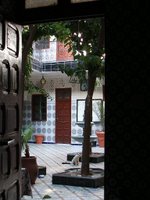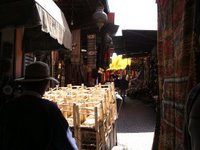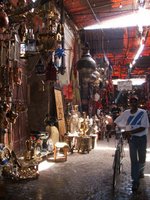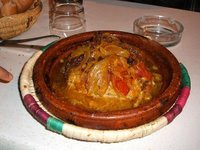Aug 21 – Introduction to Marrakesh
 Naturally, the first thing we do is to check in to our hostel (to be home for the next few nights). The usual drill, fill in passport numbers and country entry numbers, pay for first night’s accommodation. When the guy signing us in hears that our families are originally from China/HK/Sri Lanka, we get the whole Bollywood/Jackie Chan reaction. By Jackie Chan reaction, I mean that the only connection these folks have to HK is Jackie Chan films, so they begin imitating kung fu moves accompanied by ‘hiya!’ sounds. I find it more embarrassing than amusing.
Naturally, the first thing we do is to check in to our hostel (to be home for the next few nights). The usual drill, fill in passport numbers and country entry numbers, pay for first night’s accommodation. When the guy signing us in hears that our families are originally from China/HK/Sri Lanka, we get the whole Bollywood/Jackie Chan reaction. By Jackie Chan reaction, I mean that the only connection these folks have to HK is Jackie Chan films, so they begin imitating kung fu moves accompanied by ‘hiya!’ sounds. I find it more embarrassing than amusing.Hotel Afriquia of Marrakesh will be the largest hostel we stay in for all of Morocco – it has several levels as well as rooftop terraces for sleeping under the stars. Above is a picture of us hunkered down in our room - A reading our guide and saviour, Lonely Planet Morocco, while K’s omnipresent bottle of Coke sits under the bed.
 Here’s the view looking out our room door. The whole hostel is built in a square surrounding a central courtyard filled with orange trees. We have a resident cat that occasionally poops in the showers and wanders into our room to sit in the wardrobe. It was often found sleeping in the (empty) fountain in the centre of the courtyard. I remember waking up early one morning to write some postcards, and watching it have the time of its life swatting a balloon around, hurtling after it through half-open doorways to get shooed out by barely-awake residents.
Here’s the view looking out our room door. The whole hostel is built in a square surrounding a central courtyard filled with orange trees. We have a resident cat that occasionally poops in the showers and wanders into our room to sit in the wardrobe. It was often found sleeping in the (empty) fountain in the centre of the courtyard. I remember waking up early one morning to write some postcards, and watching it have the time of its life swatting a balloon around, hurtling after it through half-open doorways to get shooed out by barely-awake residents. When people ask me what my favourite part of Morocco was, my answer is the souqs. I loved wandering through the souqs with no particular agenda in mind. There was so much to take in – the colours, the wares, the smells, the people! Here are my two best shots of the souqs of Morocco. The top one was taken that first afternoon we arrived in Marrakesh – I love the lighting. The two things illuminated by the afternoon sunlight are the load of handmade stools being pushed/pulled by these two men, and the yellow fabrics up the street hanging to dry after being dyed. The picture is framed by a hanging carpet on one side, and by the pusher of the cart on the other. Most souq streets are far too narrow for motorized vehicles, so the principal methods of transporting goods are by donkey or by carts.
When people ask me what my favourite part of Morocco was, my answer is the souqs. I loved wandering through the souqs with no particular agenda in mind. There was so much to take in – the colours, the wares, the smells, the people! Here are my two best shots of the souqs of Morocco. The top one was taken that first afternoon we arrived in Marrakesh – I love the lighting. The two things illuminated by the afternoon sunlight are the load of handmade stools being pushed/pulled by these two men, and the yellow fabrics up the street hanging to dry after being dyed. The picture is framed by a hanging carpet on one side, and by the pusher of the cart on the other. Most souq streets are far too narrow for motorized vehicles, so the principal methods of transporting goods are by donkey or by carts. The second photo, taken a few days later, is of a metalware stand at the side of a street. Shafts of sunlight randomly stab down from spaces between the corrugated material draped between stall roofs. A man with a bike is walking by (bikes are another common mode of transport on these cobbled streets). The person in charge of this stall is nowhere to be seen, but his empty stool sits in the pool of sunlight – a stool very much like the ones being transported in the picture above. It is unlikely that he is far, or a neighbouring vendor is watching his stall. They’re all in cahoots with one another, we learn before long. While trying to bargain with one man, he will go a few stalls down to ‘check’ with another whether the agreed price is reasonable. While buying jewelry from a man in one shop, another man will suddenly barge in to try and sell us djellabahs (traditional hooded robes), and the jewelry shopowner has no problem at all with this.
The second photo, taken a few days later, is of a metalware stand at the side of a street. Shafts of sunlight randomly stab down from spaces between the corrugated material draped between stall roofs. A man with a bike is walking by (bikes are another common mode of transport on these cobbled streets). The person in charge of this stall is nowhere to be seen, but his empty stool sits in the pool of sunlight – a stool very much like the ones being transported in the picture above. It is unlikely that he is far, or a neighbouring vendor is watching his stall. They’re all in cahoots with one another, we learn before long. While trying to bargain with one man, he will go a few stalls down to ‘check’ with another whether the agreed price is reasonable. While buying jewelry from a man in one shop, another man will suddenly barge in to try and sell us djellabahs (traditional hooded robes), and the jewelry shopowner has no problem at all with this. After some wandering, I head back with K to the hostel to get in a nap before evening, since none of us slept well on the train. The sun sets, and we try to decide what to do for dinner. Our decision is to eat at a highly recommended mid-range restaurant at the edge of the great Djem el Fna square, which means balcony seat views of the nightfall action there. We try the specialties of the restaurant – pastille, a special tajine made in a hammam, and for myself, rabbit tajine. It is delicious (rabbit tastes like chicken), especially the combination of raisins and onions melted into the sauce.
After some wandering, I head back with K to the hostel to get in a nap before evening, since none of us slept well on the train. The sun sets, and we try to decide what to do for dinner. Our decision is to eat at a highly recommended mid-range restaurant at the edge of the great Djem el Fna square, which means balcony seat views of the nightfall action there. We try the specialties of the restaurant – pastille, a special tajine made in a hammam, and for myself, rabbit tajine. It is delicious (rabbit tastes like chicken), especially the combination of raisins and onions melted into the sauce.Next - Djem el Fna: The Great Square of Marrakesh

0 Comments:
Post a Comment
<< Home